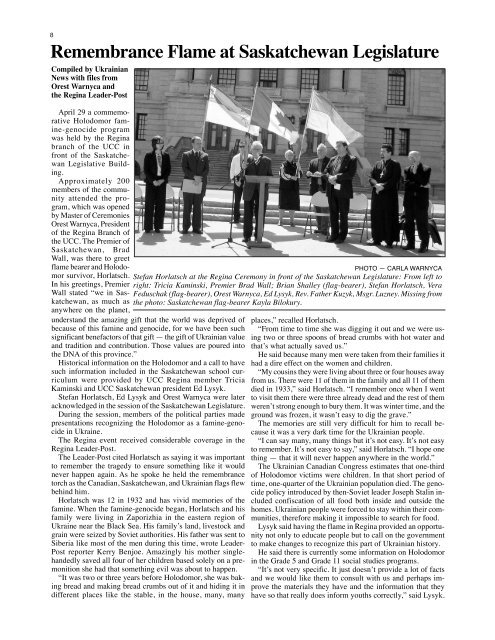Ukraine Remembers Canada Acknowledges - Holodomor
Ukraine Remembers Canada Acknowledges - Holodomor
Ukraine Remembers Canada Acknowledges - Holodomor
You also want an ePaper? Increase the reach of your titles
YUMPU automatically turns print PDFs into web optimized ePapers that Google loves.
8<br />
Remembrance Flame at Saskatchewan Legislature<br />
Compiled by Ukrainian<br />
News with files from<br />
Orest Warnyca and<br />
the Regina Leader-Post<br />
April 29 a commemorative<br />
<strong>Holodomor</strong> famine-genocide<br />
program<br />
was held by the Regina<br />
branch of the UCC in<br />
front of the Saskatchewan<br />
Legislative Building.<br />
Approximately 200<br />
members of the community<br />
attended the program,<br />
which was opened<br />
by Master of Ceremonies<br />
Orest Warnyca, President<br />
of the Regina Branch of<br />
the UCC. The Premier of<br />
Saskatchewan, Brad<br />
Wall, was there to greet<br />
flame bearer and <strong>Holodomor</strong><br />
survivor, Horlatsch.<br />
In his greetings, Premier<br />
Wall stated “we in Saskatchewan,<br />
as much as<br />
anywhere on the planet,<br />
PHOTO — CARLA WARNYCA<br />
Stefan Horlatsch at the Regina Ceremony in front of the Saskatchewan Legislature: From left to<br />
right: Tricia Kaminski, Premier Brad Wall; Brian Shalley (flag-bearer), Stefan Horlatsch, Vera<br />
Feduschak (flag-bearer), Orest Warnyca, Ed Lysyk, Rev. Father Kuzyk, Msgr. Luzney. Missing from<br />
the photo: Saskatchewan flag-bearer Kayla Bilokury.<br />
understand the amazing gift that the world was deprived of<br />
because of this famine and genocide, for we have been such<br />
significant benefactors of that gift — the gift of Ukrainian value<br />
and tradition and contribution. Those values are poured into<br />
the DNA of this province.”<br />
Historical information on the <strong>Holodomor</strong> and a call to have<br />
such information included in the Saskatchewan school curriculum<br />
were provided by UCC Regina member Tricia<br />
Kaminski and UCC Saskatchewan president Ed Lysyk.<br />
Stefan Horlatsch, Ed Lysyk and Orest Warnyca were later<br />
acknowledged in the session of the Saskatchewan Legislature.<br />
During the session, members of the political parties made<br />
presentations recognizing the <strong>Holodomor</strong> as a famine-genocide<br />
in <strong>Ukraine</strong>.<br />
The Regina event received considerable coverage in the<br />
Regina Leader-Post.<br />
The Leader-Post cited Horlatsch as saying it was important<br />
to remember the tragedy to ensure something like it would<br />
never happen again. As he spoke he held the remembrance<br />
torch as the Canadian, Saskatchewan, and Ukrainian flags flew<br />
behind him.<br />
Horlatsch was 12 in 1932 and has vivid memories of the<br />
famine. When the famine-genocide began, Horlatsch and his<br />
family were living in Zaporizhia in the eastern region of<br />
<strong>Ukraine</strong> near the Black Sea. His family’s land, livestock and<br />
grain were seized by Soviet authorities. His father was sent to<br />
Siberia like most of the men during this time, wrote Leader-<br />
Post reporter Kerry Benjoe. Amazingly his mother singlehandedly<br />
saved all four of her children based solely on a premonition<br />
she had that something evil was about to happen.<br />
“It was two or three years before <strong>Holodomor</strong>, she was baking<br />
bread and making bread crumbs out of it and hiding it in<br />
different places like the stable, in the house, many, many<br />
places,” recalled Horlatsch.<br />
“From time to time she was digging it out and we were using<br />
two or three spoons of bread crumbs with hot water and<br />
that’s what actually saved us.”<br />
He said because many men were taken from their families it<br />
had a dire effect on the women and children.<br />
“My cousins they were living about three or four houses away<br />
from us. There were 11 of them in the family and all 11 of them<br />
died in 1933,” said Horlatsch. “I remember once when I went<br />
to visit them there were three already dead and the rest of them<br />
weren’t strong enough to bury them. It was winter time, and the<br />
ground was frozen, it wasn’t easy to dig the grave.”<br />
The memories are still very difficult for him to recall because<br />
it was a very dark time for the Ukrainian people.<br />
“I can say many, many things but it’s not easy. It’s not easy<br />
to remember. It’s not easy to say,” said Horlatsch. “I hope one<br />
thing — that it will never happen anywhere in the world.”<br />
The Ukrainian Canadian Congress estimates that one-third<br />
of <strong>Holodomor</strong> victims were children. In that short period of<br />
time, one-quarter of the Ukrainian population died. The genocide<br />
policy introduced by then-Soviet leader Joseph Stalin included<br />
confiscation of all food both inside and outside the<br />
homes. Ukrainian people were forced to stay within their communities,<br />
therefore making it impossible to search for food.<br />
Lysyk said having the flame in Regina provided an opportunity<br />
not only to educate people but to call on the government<br />
to make changes to recognize this part of Ukrainian history.<br />
He said there is currently some information on <strong>Holodomor</strong><br />
in the Grade 5 and Grade 11 social studies programs.<br />
“It’s not very specific. It just doesn’t provide a lot of facts<br />
and we would like them to consult with us and perhaps improve<br />
the materials they have and the information that they<br />
have so that really does inform youths correctly,” said Lysyk.


